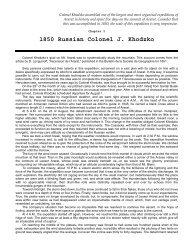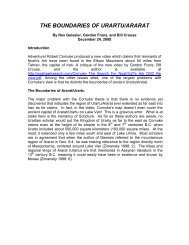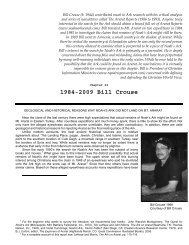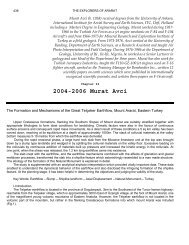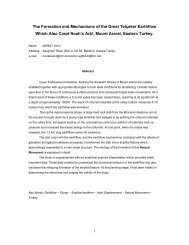1876 British Viscount & Ambassador James Bryce - Noah's Ark Search
1876 British Viscount & Ambassador James Bryce - Noah's Ark Search
1876 British Viscount & Ambassador James Bryce - Noah's Ark Search
Create successful ePaper yourself
Turn your PDF publications into a flip-book with our unique Google optimized e-Paper software.
170 THE EXPLORERS OF ARARAT<br />
make out the white cone of Ararat. Nearer at hand, only forty miles to the north, rose the huge extinct volcano of Ala<br />
Göz, with its three sharp black rocky peaks enclosing an ancient crater, in whose bottom were patches of snow; and,<br />
nearer still, the dim plain of Erivan encircled the mountain to the north and east, with the Araxes winding like a faint<br />
streak of silver through it. A slight rise in the ground showed where Erivan itself lay, but the bright green of the<br />
orchards and vineyards round it was lost at this distance, though, standing in the market-place of the city, Ararat<br />
seems to tower right over the spectator’s head. Northwest the upper valley of the Araxes could be traced as far as Ani,<br />
once the capital of the Armenian kingdom, and the great Russian fortress of Alexandropol, and the hills where Kars, its<br />
enemy, looks forth defiance. To the south and southwest the eye ranged over a wilderness of bare red-brown<br />
mountains, their sides seamed by winter torrents that showed in the distance like dark lines, not a tree nor a patch of<br />
green on their scorched and arid slopes, scarcely even a fleck of snow on their tops, though many rose more than<br />
10,000 or 11,000 feet above the sea. Prominent among them was the long stern line of hills that enclose the upper<br />
course of the Euphrates (the Eastern Euphrates or Murad Su), whose source could be distinguished about forty miles<br />
to the south, beyond the hollow where Bayazid lies, the houses of which were hidden by a low ridge. Still further to the<br />
south, from the shores of the Lake of Van, rose the great volcanic peak of Sipan Dagh, and to the southeast the<br />
stupendous masses of Savalan Dagh, that look over all Azerbijan to the waves of the Caspian. Neither the Lake of Van<br />
nor the still larger Lake of Urumia was visible; for both, though high above the sea, are enclosed by lofty hills. But far<br />
beyond them, more than two hundred miles away, I could just descry the faint blue tops of the Assyrian mountains of<br />
Southern Kurdistan, the Qardu land, where Chaldee tradition places the fragments of the <strong>Ark</strong>, mountains that look<br />
down on Mosul and those huge mounds of Nineveh by which the Tigris flows. Below and around, included in this<br />
single view, seemed to lie the whole cradle of the human race, from Mesopotamia in the south to the great wall of the<br />
Caucasus that covered the northern horizon, the boundary for so many ages of the civilized world. If it was indeed here<br />
that man first set foot again on the unpeopled earth, one could imagine how the great dispersion went as the races<br />
spread themselves from these sacred heights along the courses to the great rivers down to the Black and Caspian<br />
Seas, and over the Assyrian plain to the shores of the Southern Ocean, whence they were wafted away to other<br />
continents and isles. No more imposing center of the world could be imagined. In the valley of the Araxes beneath, the<br />
valley which Armenian legend has selected as the seat of Paradise, the valley that has been for three thousand years<br />
the high-road for armies, the scene of so much slaughter and misery, there lay two spots which seemed to mark the<br />
first and the latest points of authentic history. One, right below me, was the ruined Artaxata, built, as the tale goes, by<br />
Hannibal, and stormed by the legions of Lucullus. The other, far to the northwest, was the hollow under the hills in<br />
which lies the fortress of Kars, where our countrymen fought in 1854, and where the flames of war were so soon again<br />
to be lighted.<br />
Yet how trivial history, and man the maker of history, seemed. This is the spot which he reveres as the supposed<br />
scene of his creation and his preservation from the destroying waters, a land where he has lived and labored and dies<br />
ever since his records begin, and during ages from which no record is left. Dynasty after dynasty has reared its<br />
palaces, faith after faith its temples, upon this plain; cities have risen and fallen and risen again in the long struggle of<br />
civilization against the hordes of barbarism. But of all these works of human pomp and skill, not one can be discerned<br />
from this height. The landscape is now what it was before man crept forth on the earth; the mountains stand about the<br />
valleys as they stood when the volcanic fires that piled them up were long ago extinguished. Nature sits enthroned,<br />
serenely calm, upon this hoary pinnacle, and speaks to her children only in the storm and earthquake that level their<br />
dwellings in the dust. As says the Persian poet:<br />
“When you and I behind the veil have passed,<br />
O but the long long while the world shall last,<br />
Which of our coming and departure heeds<br />
As the Seven Seas should heed a pebble’s cast.”<br />
Yet even the mountains change and decay. Every moment some block thunders from these crags into the glens<br />
below. Day by day and night by night frost, snow, and rain are loosening the solid rock, and the ceaseless action of<br />
chemical forces is dissolving it into its primal elements, setting free the gases, and delivering over the fragments to<br />
torrents that will sweep them down into the plain. A time must come, if the world lasts long enough, when even the<br />
stately peaks of Ararat will have crumbled away and be no more. “Of old hast thou laid the foundations of the earth:<br />
and the heavens are the work of the hands. They shall perish, but thou shalt endure: they all shall wax old as doth a<br />
garment; and as a vesture shalt thou change them, and they shall be changed; but thou art the same, and thy years<br />
fail not.”<br />
In addition I am bound to say that the view, spite of the associations it evoked, spite of the impression of awe and<br />
mystery it gave, was not beautiful or splendid, but rather stern, grim, and monotonous. The softer colors of the<br />
landscape seemed to be lost; the mountains, seen from above and seldom showing well-marked peaks, were uncouth,<br />
rough-hewn masses. One had a sense of vast sterility and dreariness as the vision ranged over this boundless<br />
expanse of brown, and sought, almost in vain, a point to recognize. For most of these huge mountains are nameless<br />
on our maps; and these bare valleys are peopled by races of whom we know little except that they live now much as<br />
they may have lived when that first dispersion of mankind took place. Then suddenly, while the eye was still unsatisfied



